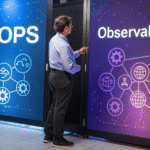AI Transparency Tools: The Key to Ethical AI Development

AI transparency tools ensure ethical AI development by making machine learning models understandable and accountable. These tools help businesses, regulators, and users gain insights into AI decisions, reducing risks and biases. By promoting trust, transparency tools encourage responsible AI adoption. This article explores their benefits, top tools, and the impact on ethical AI practices.
Artificial Intelligence (AI) is transforming industries. However, its rapid growth raises ethical concerns. AI transparency tools help address these issues by making AI systems more understandable. These tools ensure fairness, prevent bias, and increase trust.

What Is AI Transparency?
AI transparency means making artificial intelligence (AI) systems clear and understandable. It ensures that people know how AI makes decisions, what data it uses, and why it gives specific results. When AI is transparent, users, businesses, and regulators can trust it more. Transparency also helps detect and fix unfair biases, making AI systems more reliable and fair.
Many AI models work like “black boxes,” where the decision-making process is hidden. AI transparency tools help open these black boxes, explaining how AI systems think and act. By using these tools, companies can ensure their AI is ethical, fair, and accountable.
AI transparency also supports laws and regulations that require businesses to explain AI decisions. With more transparency, AI can be a powerful tool for good, benefiting people and society as a whole.
Why Is AI Transparency Important?
AI transparency is essential for several reasons:
- Trust: Consumers are more likely to trust systems when they understand how decisions are being made. Transparent AI reduces fears of hidden biases, errors, or unfair practices.
- Accountability: Transparency ensures that those who develop and deploy AI systems can be held accountable for the outcomes produced by these systems. This accountability helps mitigate the risk of harm caused by AI’s decisions.
- Ethical Considerations: Transparency in AI can help detect and mitigate biases that may unintentionally discriminate against certain groups, ensuring fairness across applications like hiring, loan approvals, and even criminal justice.
- Compliance with Regulations: As governments introduce more regulations around AI usage, transparency helps businesses stay compliant with legal standards and ethical guidelines.
Best AI Transparency Tools
1. IBM AI Explainability 360
- This is an open-source toolkit that helps explain how AI models make decisions.
- It provides different ways to interpret AI predictions, making AI systems more understandable.
- Businesses and developers can use it to detect and reduce bias in AI models.
- It supports multiple programming languages, making it accessible to different users.
2. Google’s What-If Tool
- A user-friendly tool that lets people explore how AI models make decisions.
- It allows users to test different scenarios and see how AI predictions change.
- Helps developers understand how changes in input data affect the results.
- Supports machine learning models from TensorFlow and other AI platforms.
3. Microsoft InterpretML
- Designed to make AI predictions easier to understand.
- It provides insights into why AI made a certain decision.
- Useful for businesses that need to comply with AI regulations and explain their AI models to customers.
- Supports multiple machine learning models and frameworks.
4. SHAP (SHapley Additive exPlanations)
- A widely used tool that helps break down AI decisions step by step.
- Shows how much each factor influenced the final prediction.
- Helps businesses detect unfair biases and improve AI fairness.
- Works well with different AI models and is used in healthcare, finance, and other industries.
5. LIME (Local Interpretable Model-agnostic Explanations)
- Highlights important factors behind AI predictions.
- Provides easy-to-understand explanations for AI decisions.
- Works with many AI models and applications.
- Helps businesses and developers make AI more transparent and reliable.
6. Fiddler AI
- A platform that provides deep insights into AI models.
- Helps detect AI bias, monitor AI performance, and improve transparency.
- Supports real-time AI monitoring, making it easier for companies to track AI behavior.
- Used by businesses to ensure AI decisions are fair and accountable.
7. Aequitas
- A fairness audit tool that helps detect discrimination in AI models.
- Helps developers and businesses check if their AI systems treat all users fairly.
- Provides detailed reports on fairness and bias in AI.
- Used in social services, hiring, and finance to ensure ethical AI use.
8. H2O Driverless AI
Reduces the risk of bias and increases AI accountability.
An AI tool that explains how its predictions are made.
Uses advanced techniques to make AI transparency easier.
Helps businesses and data scientists understand and improve AI models.

Benefits of AI Transparency Tools
1. Increased Trust and Confidence
When people understand how AI makes decisions, they are more likely to trust the technology. This is especially important for businesses that use AI in customer interactions, healthcare, and finance. AI transparency tools help build trust by explaining AI outcomes in simple terms.
2. Improved Fairness and Reduced Bias
AI systems can sometimes be biased, leading to unfair decisions. Transparency tools help detect and fix these biases, ensuring that AI treats everyone fairly. This is essential in hiring, lending, and law enforcement, where biased AI can have serious consequences.
3. Stronger Compliance with Regulations
Governments and organizations worldwide are introducing laws that require AI transparency. Businesses using these tools can easily comply with regulations like GDPR and the AI Act, avoiding legal risks and penalties.
4. Better Decision-Making
When businesses know how AI arrives at decisions, they can make better choices. Transparency tools allow companies to evaluate AI suggestions, reject bad recommendations, and improve their AI systems.
5. Enhanced Customer Experience
Customers feel more comfortable using AI-powered services when they understand how decisions are made. AI transparency tools provide clear explanations, increasing customer satisfaction and loyalty.
6. Increased AI Accountability
Organizations using AI must take responsibility for their systems. Transparency tools help track AI performance, ensuring it operates as expected. If something goes wrong, businesses can quickly find and fix the issue.
7. Protection Against AI Misuse
Without transparency, AI can be used in harmful ways, such as spreading misinformation or discriminating against certain groups. Transparency tools help prevent misuse by ensuring AI systems follow ethical guidelines.
8. Competitive Advantage
Companies that use transparent AI gain a competitive edge. Consumers and investors prefer businesses that use AI responsibly. Transparency helps businesses stand out in the market by showing commitment to fairness and ethics.
9. Reduced Legal and Financial Risks
AI-related lawsuits and penalties are increasing as regulations tighten. Businesses that use transparency tools can minimize legal and financial risks by ensuring AI decisions are fair and well-documented.
10. Encourages Responsible AI Development
AI transparency tools promote responsible AI use by ensuring that AI benefits everyone, not just a select few. This leads to more ethical AI development and greater public trust in AI technologies.
Challenges of AI Transparency
While AI transparency tools offer numerous benefits, they come with their own set of challenges. Here are some of the most common obstacles businesses may face:
- Complexity of AI Models: Some AI models, particularly deep learning networks and neural networks, can be highly complex and difficult to interpret. These models may process data in ways that are not easily understood by humans, which can hinder the effectiveness of these tools.
- Data Privacy: Transparency requires access to data used by AI systems. However, this can raise significant data privacy concerns. For example, sensitive personal information may be required for transparency, which may conflict with privacy regulations or user consent agreements.
- High Costs of Implementation: Implementing AI transparency tools can be costly, particularly for small and medium-sized enterprises (SMEs). The costs of developing, maintaining, and auditing AI systems for transparency can be a significant barrier to adoption.
- Vulnerability to Manipulation: Just as AI transparency tools can help ensure ethical practices, they can also be targeted by bad actors. Hackers may attempt to manipulate transparency tools to alter the decision-making processes of AI systems, leading to biased or unfair outcomes.
Best Practices for Implementing AI Transparency
1. Define Clear AI Transparency Goals
Before implementing AI transparency tools, businesses should define their objectives. Do they need to explain AI decisions to customers, ensure fairness, or meet legal requirements? Setting clear goals helps select the right tools and strategies.
2. Use User-Friendly AI Transparency Tools
Choose AI tools that provide clear and simple explanations. Tools-like SHAPE and LIME break down complex AI models into understandable insights. This helps both technical and non-technical users understand AI decisions.
3. Regularly Audit AI Models for Bias
AI systems can develop biases over time. Businesses should conduct regular audits using tools like Aequitas to detect and correct biases. This ensures AI remains fair and does not discriminate against certain groups.
4. Provide Clear Explanations to Users
Users need to understand AI decisions, especially in industries like finance, healthcare, and hiring. Businesses should provide easy-to-read explanations of AI predictions and how they affect users.
5. Train Employees on AI Transparency
Employees should be trained on AI transparency principles and tools. They need to understand how AI makes decisions and how to use transparency tools effectively. Training helps build AI literacy across the organization.
6. Ensure Compliance with AI Regulations
Governments are introducing AI regulations that require transparency. Businesses should stay updated on laws like the EU AI Act and GDPR. Using AI transparency tools can help meet these legal requirements.
7. Make AI Accountability a Priority
Businesses should take responsibility for AI decisions. They should monitor AI performance, document decisions, and address issues promptly. This helps build trust with customers and regulators.
8. Continuously Improve AI Transparency Practices
AI technology is constantly evolving. Businesses should update their AI transparency strategies regularly. They should adopt new tools and best practices to keep AI systems fair, ethical, and accountable.
The Future of AI Transparency
As AI continues to evolve, so too will the need for greater transparency. The increasing complexity of AI models, as well as the growing reliance on AI systems across all sectors, means that the demand for clear, understandable, and accountable AI will only rise.
The future of AI transparency will likely involve more sophisticated tools and frameworks to make AI systems not just explainable, but also comprehensible to non-experts.
Moreover, with more industries adopting AI, the importance of regulatory frameworks will grow. We can expect stricter regulations and greater emphasis on ethical AI development in the future.
It will be crucial in helping businesses stay ahead of these regulatory changes and ensure that their systems remain fair and compliant.
Conclusion: The Key to Ethical AI Development
In conclusion, AI transparency tools are essential for building ethical, trustworthy, and accountable AI systems. These tools help businesses explain how their AI models work, detect and mitigate biases, and ensure compliance with evolving legal and ethical standards.
As AI continues to shape our future, embracing transparency is not just a best practice—it’s a necessity. By prioritizing transparency, businesses can ensure that AI is used ethically and responsibly, benefiting both consumers and society at large.
In the years to come, AI transparency will become a cornerstone of responsible AI development, fostering a future where AI is trusted, understandable, and aligned with human values.
What are AI transparency tools?
AI transparency tools help explain how AI systems make decisions, ensuring fairness and accountability.
How do AI transparency tools improve ethical AI?
They analyze AI decision-making, detect biases, and make AI systems more interpretable and trustworthy.
Are these tools necessary for all businesses?
Any business using AI for critical decisions should consider these tools to ensure ethical AI practices.
Can AI transparency tools eliminate all bias?
No, but they help minimize biases by identifying and mitigating them in AI models.
Do AI transparency tools make AI slower?
Some tools may slightly impact performance, but the benefits of ethical AI outweigh minor delays.
Which industries benefit from AI transparency tools?
Finance, healthcare, e-commerce, and government sectors benefit the most from ethical AI practices.
How much do AI transparency tools cost?
Costs vary, but investing in AI transparency saves businesses from potential legal and reputational risks.



